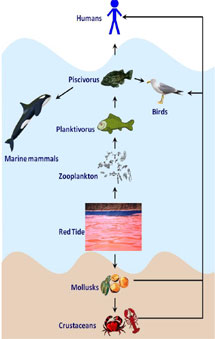Hello readers! Let me take you on an aquatic journey to understand what is this ‘good’ that can ‘turn bad’? It is a very simple, yet a very important story, and has direct implications on our day-to-day life. This story is basically about the microscopic plants (algae) which live in almost all water bodies. They contain chlorophyll pigment and can prepare their own food using solar energy (photosynthesis). Hence, they are said to be autotrophic. The moment I say they are microscopic plants, it is obvious that these plants cannot be seen with the naked eyes. Still, they play an important role because they are plants.
We all know that terrestrial plants are important because they provide us with our life support, and that is oxygen. However, a majority of us might be unaware that only 50 percent of the total atmospheric oxygen is produced by terrestrial plants, and the remaining 50 percent is contributed by phytoplankton. Hence, it wouldn’t be wrong to say that every second breath of a person is due to phytoplanktons. Such tiny organisms and such an important role they play in the world. It’s worth a thought!
The role of phytoplankton
Phytoplankton are primary producers. They form the first stage of most aquatic food chains. They are eaten by primary consumers (zooplankton), which are in turn, eaten by secondary and tertiary consumers (small and large fish). In simple words, this food chain is connected from phytoplankton to whales; phytoplankton serve as the base of this chain. In addition to this, phytoplankton are also actively involved in fixing atmospheric carbon dioxide. These phytoplankton may either die or be eaten by other larger organisms. Once they die, the carbon dioxide fixed by them will settle along with the carcass on the seabed. Similarly, those organisms that feed on phytoplankton may excrete carbon in the form of faecal pellets, which again settle at the bottom of the ocean. This carbon remains here for several hundreds of years. This mechanism adopted by Mother Nature is beneficial to control the ever-increasing global warming.
Just as every coin has two sides, although phytoplankton significantly benefit mankind and the aquatic ecosystem, they may also cause some harm. In certain circumstances (due to natural phenomena or anthropogenic activities), these microscopic plants grow to such high numbers that they can change the colour of the water, and such conditions are termed as algal blooms or red tides. This proliferation of algae can cause massive fish kills, contaminate seafood with toxins and alter the ecosystem; such blooms are generally termed as Harmful Algal Blooms (HABs).
The harmful blooms
These HABs may be toxic or non-toxic depending on their ability to produce toxins. This depends on the type of species that is responsible for the bloom. We can broadly classify bloom-forming phytoplankton species into three types: 1) Those that proliferate and discolour the water to the extent that the water turns so dense that it forms a canopy that blocks sunlight penetration into the water, and thus can cause damage to other autotrophic life present in the water body. In addition to this, dense blooms on decomposition can cause anoxia (absence of dissolved oxygen) and lead to indiscriminate mortality of aquatic life. 2) Species that produce toxins that can affect the gastrointestinal system and cause neurological illness to humans by entering into their system through sea food. 3) Species that are non-toxic to humans, but can kill invertebrates and fishes by clogging their gills. HABs may also have adverse effects on tourism and the food industry.

Among the toxic phytoplankton, there are few which can produce toxins that can cause serious and potentially deadly illnesses in humans. Basically, these toxins make their entry into the human digestive system through seafood, mostly through shellfish bivalves (clams, mussels, oysters etc.) These shellfish are the main victims of such toxins because of their filter-feeding habit; that is, they feed themselves by filtering the waters from their surroundings to capture the microorganisms present in the water. However, during such feeding mechanism, they keep accumulating the biotoxins present in the surrounding water (if toxic species of phytoplankton present in the water or during a bloom of toxic species,), and this accumulation of biotoxin in the shellfish tissues can cause illness to those who consume them. It is vital to understand the types of illness that occur due to consumption of shellfish with a high level of toxins, and also the symptoms of these illnesses. Actually, there are many toxic phytoplankton, but here I am going to tell you about only those which are more dangerous to human health, and such illnesses are as follows: a) Paralytic Shellfish Poisoning (PSP), b) Diarrhetic Shellfish Poisoning (DSP), and c) Amnesic Shellfish Poisoning (ASP).
The PSP is mainly caused due to the saxitoxin, a neurotoxin produced by phytoplankton, and the symptoms of PSP are a tingling sensation or numbness on face that starts from lips and spreads all over the face and neck, a prickly sensation at fingertips and toes, headache, dizziness, and in extreme cases, paralysis of respiratory muscles and death in a few hours. The DSP is caused due to okadaic acid produced by phytoplankton and the symptoms of the illness are; abdominal cramps, diarrhoea, vomiting and headache, and the symptoms occur within an hour of consumption. The ASP is caused due to domoic acid produced by marine phytoplankton, and the symptoms are as follows; nausea, vomiting, muscle weakness and memory loss. In extreme cases, death can occur. However, it is essential to seek medical assistance in any of the above illnesses, based on the severity of the symptoms.
The India story
It is evident that these phytoplankton blooms are problematic for the ecosystem as well as for human health. Adding to our concerns, these events are increasing worldwide over the years. A research survey by D’Silva et al., (2012) indicates the status of Indian waters in the context of HABs. In our research, we found that in the five decades HAB episodes along the Indian coast have shown an increasing trend. The reason for such increased HAB events could be because of: (1) Growing awareness (researchers started noticing the blooms, or else in the past such booms might have gone unnoticed) or improved research methods and techniques, (2) Species dispersal through currents, storms or cyclones, (3) Bioinvasion through ship ballast water, and (4) Eutrophication (nutrient enrichment) in coastal waters. These reasons may vary from one bio-region to the other, depending on the regional environmental settings. With the global increase in algal blooms, it becomes necessary for every maritime country to have an understanding of the algal bloom scenario in their territorial water bodies.
Regular physical monitoring in coastal waters by researchers might not be a feasible option; however, the awareness among coastal dweller can solve the purpose at a significant level. It is also important to transfer this scientific vision to social vision for the benefit of society, that would otherwise be affected either in terms of health or the economy. It is clear that on a relative scale, anthropogenic activities are contributing more in increasing events of HABs. In other words, we are unknowingly playing with our second breath and contributing into it turning from good to bad. It’s time for bridging the gap between the scientist and the common man to establish a stronger network for bloom detection in coastal waters.


 [/column]
[/column]